
| WWT Shows | CLICK TO: Join and Support Internet Horology Club 185™ | IHC185™ Forums |

|
• Check Out Our... • • TWO Book Offer! • |
Welcome Aboard IHC185™  Internet Horology Club 185
Internet Horology Club 185  IHC185™ Discussion Site Main Page
IHC185™ Discussion Site Main Page  Horological Discussions, Questions and Answers
Horological Discussions, Questions and Answers  Military Timepiece Discussions - EXCLUSIVE!
Military Timepiece Discussions - EXCLUSIVE!  Waltham Military Timepieces
Waltham Military Timepieces
 Internet Horology Club 185
Internet Horology Club 185  IHC185™ Discussion Site Main Page
IHC185™ Discussion Site Main Page  Horological Discussions, Questions and Answers
Horological Discussions, Questions and Answers  Military Timepiece Discussions - EXCLUSIVE!
Military Timepiece Discussions - EXCLUSIVE!  Waltham Military Timepieces
Waltham Military TimepiecesPage 1 2
Go  | New Topic  | Find-Or-Search  | Notify  | Tools  | Reply to Post  |  |
Here is an assortment of Waltham military timepieces from my collection. 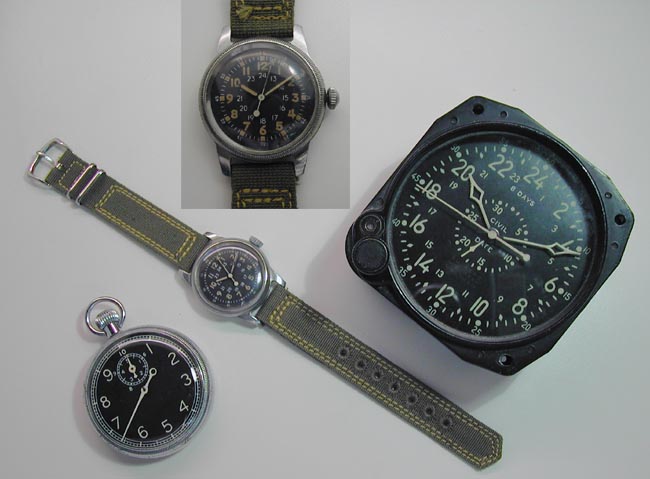 | |||
|
Nice collection Jerry, did it take a while to find these timepeices? Was the clock used in millitary aircraft of ww 2? | ||||
|
| Life Achievement Military Expert |
Great collection, Jerry! Thank you for your post. Is that wristwatch an A-17? Also, what is marked upon the back of your stopwatch? The stopwatch appears to be the type used for air navigation. The clock is WWII vintage and well regarded by collectors. Some are marked for US Navy Aviation use, others for the US Army Air Corps. Best regards, Greg | |||
|
The decal on the back of my clock that had any ordnance notations is nearly gone and illegible, however the dial is marked "B.U.AERO/U.S.NAVY/WALTHAM". Also, here is a pic of the back of the watches. 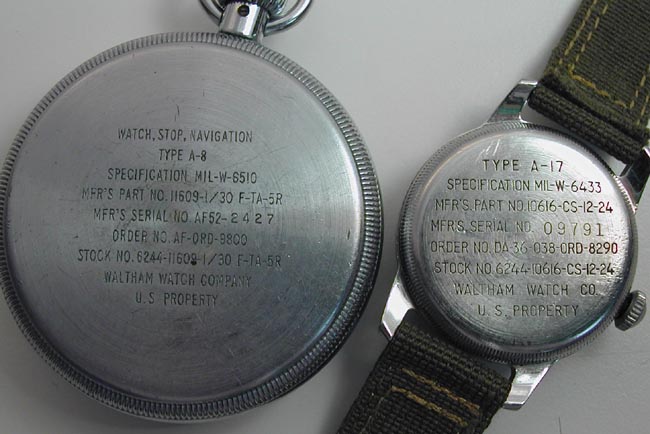 | ||||
|
| IHC Life Member |
Thanks for sharing Jerry. Very nice! | |||
|
When I worked at the Library/Information Center at the Oak Ridge Gaseous Diffusion Plant, operated by Union Carbide, Martin-Marietta, and Lockheed Martin, we had an extensive collection of Federal and Military standards and specifcations on microfilm. The collection included historical specs and standards. I recall looking up a couple specs for hack watches. I suspect the collection is still available in the Engineering Libraries at some universities and colleges. Before we lost our funding from DOE they had been issued on cd's and could be remotely accessed through a computer system that connected all the technical/special libraries in Oak Ridge. | ||||
|
| Life Achievement Military Expert |
An extra nice A-17 wristwatch. The band appears to be the type supplied with the watch by Waltham. The stopwatch looks like a Korean war vintage item. That's interesting info regarding the specs. I'll have to see about obtaining them sometime. Best regards, | |||
|
MIL-W-3818B, dated 17 October 1962, is the specification for watch, wrist, DTU-2A/P. It supersedes MIL-W-3818A which was issued 12 March 1956. I have no information on when the original 3818 was issued. | ||||
|
| Life Achievement Military Expert |
Here we have a Waltham “Admiralty Pattern No. 6" stop watch. It is calibrated based upon the time it takes for sound to travel through sea water. These timers were used along with the Azdic sonar apparatus on board anti-submarine warships. These timers working in conjunction with the Azdic devises permitted an accurate plotting of the range, speed and direction of U-Boats. This information was used for setting the timers of depth charges to explode at the correct depth. On the back is the issue number and the broad arrow property marking. 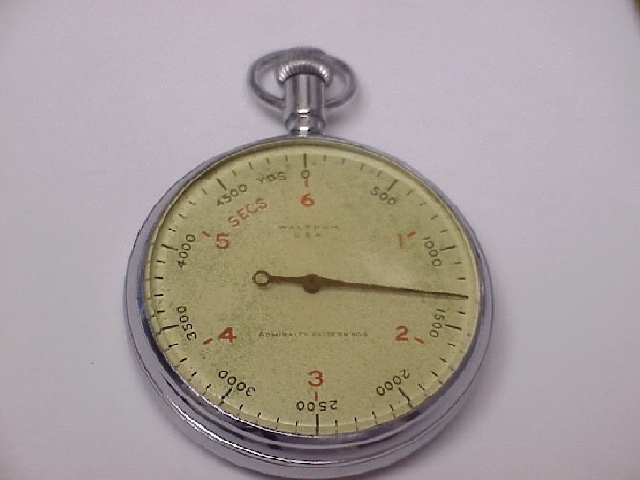 | |||
|
Enclosed is a pic of two tactical watches from WW-2 vintage--a Bulova on the left and an Elgin on the right. By tactical watches, these had the black subdued dial and the hack set for synchronization. These were issued to line combat troops. This differs from the garrison watches that are shown in the next pic. Tom 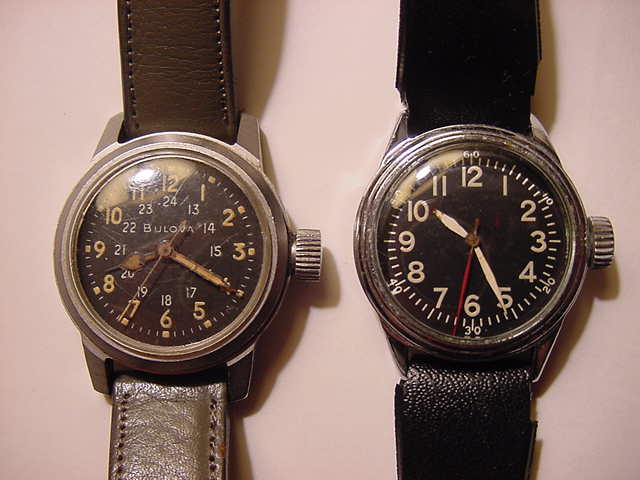 | ||||
|
Enclosed here is a pic of three garrison watches from WW-2 vintage. Left is an Elgin, Center is a Hamilton, and Right is a Bulova. These always had white or buff dials and were not hack set. These were issued to combat service support troops, ie supply, medical, transportation, etc. This bit of trivia on the difference between tactical and garrison watches came to me during my 27 year career in the Army. Very early in my career, in the 1960's, we had an old supply sgt who had served in ww-2. He is the one who told me the difference. Who am I to argue with a crusty old NCO with 30+ years in this man's army. Tom, LTC, retired 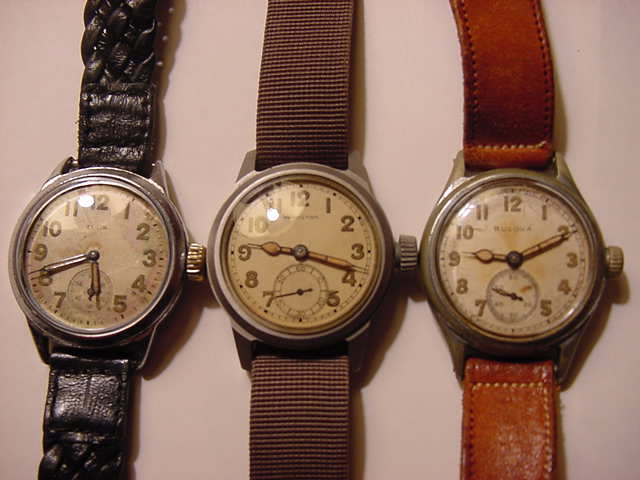 | ||||
|
| Life Achievement Military Expert |
Hi Tom. Thanks for providing us with the knowledge of your old Sargent regarding “garrison” watches and “tactical” hack watches during WWII. I rather like the distinction, "garrison" and "tactical" for these watches. Over the years, I have noticed that the same make and model of black dial sweep second hack-watch can be found with either US Army Air Corps markings or occasionally with US Army Ordinance markings on the case back. From another source, I was informed that watches with sweep second hands were also popular with military nurses for taking pulses and such. I suppose there must be a WWII vintage manual regarding what was to be issued to whom. I would suppose that in such a manual the terms “garrison” and “tactical” might be used to describe these items. Best regards, Greg | |||
|
Greg, What you want to look for to see what was to be issued to whom is called a TO&E (Table of organization and equipment). This is the document for all organizations and units set up in the army in a specific structure. This document spells out exactly what equipment is authorized and to whom it is to be issued. If it is not in the TO&E, you can't order it, stock it, or issue it. That is unless you use midnight auto supply. Another document you may look for is called a TDA (Table of distribution and allowances). This is similar to a TO&E, and has the same function, but is used for service support organizations whose mission might change. The TDA can expand or contract depending upon the mission of the using unit. Thse are long, involved documents, and you would have to screen through to find watches. The watch would be listed by line item, stock number and nominclature, and number authorized. Tom | ||||
|
| IHC President Life Member |
This one is similar to but perhaps a bit later than the lower left in Jerry's montage above. I've always been told this Waltham "Type A-8" is considered a "Bomb Timer" but it probably has numerous navigational uses as well. Each sweep is ten seconds and of course it will count elapsed time as well. Any additional details on these interesting timers and how they were used would be greatly appreciated. By the way, if you get into one of these, the bezels on mine unscrew, they are not snap-fit as they appear to be at first glance. "Waltham Bomb Timer" ten seconds sweep, also elapsed time... 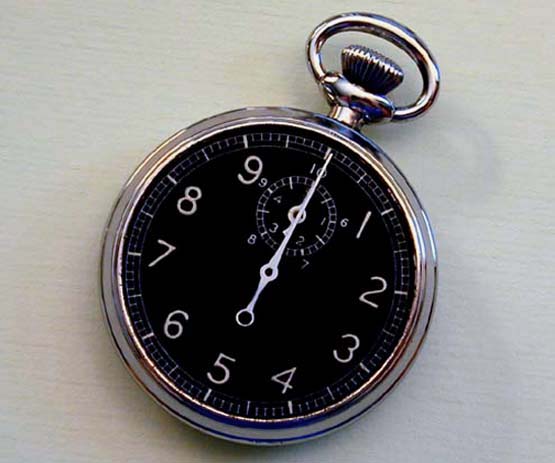 | |||
|
| IHC President Life Member |
9-Jewel movement, fast moving balance, sounds like a cricket... 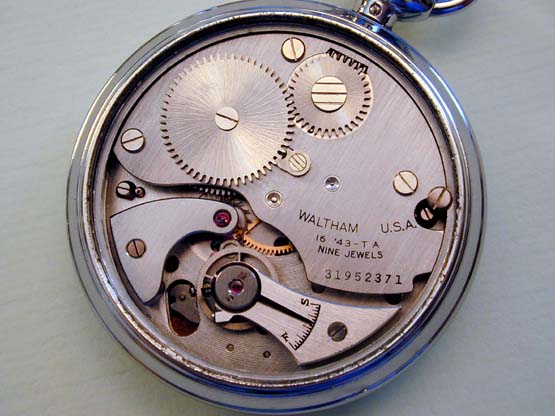 | |||
|
| IHC President Life Member |
Crisp and clear "Type A-8" case markings along with "Waltham" 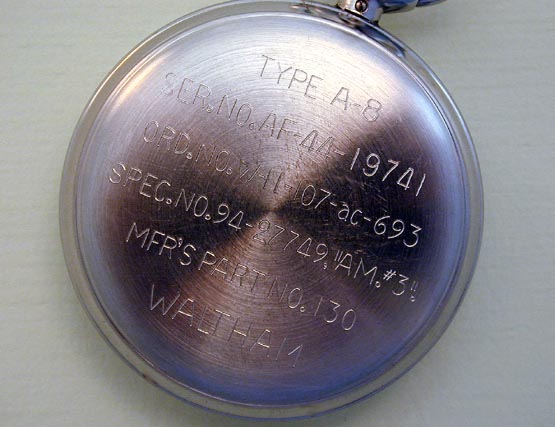 | |||
|
| Life Achievement Military Expert |
Lindell, a super example! The movement serial number would place this in 1944. Thanks for another great post. Best regards, Greg | |||
|
This posting is in response to Jerry Treiman's 30 Aug. 2004 postng (at the beginning of this topic) showing some of his Waltham military timepiece collection. I have a Waltham 8 day Navy Aviation clock identical to the one in your picture, but I can't read one of the lines on the back. I can read "CONTRACT NO." and the numbers within a white bordered rectangle, however the next line I can't read the written text, but I can read the number in the white rectangle. The next line is MFR'S PART NO. which is ledgbile. Can you tell me what the wording is suppose to read for the second number? Thanks Ed | ||||
|
Ed - unfortunately the label is almost completely gone from mine. Maybe someone else has an example that is still legible. | ||||
|
The clock is a Model CDIA aircraft clock. These were first produced starting in 1941 and were made in large numbers with 134,000 of them being supplied between 1941 and 1944. My understanding that they were made after the war as well. CDIA stands for Civil Date Indicator Aeronautic. The label to which you are referring should read: CONTRACT NO. F.S.S.C. NO. MFR'S Part NO. WALTHAM WATCH COMPANY with the appropriate numbers/letters entered into white rectangular boxes that follow the first three lines. For example, on these types of clocks the MFR'S PART NO. box should be filled in with the letters "CDIA" and the CONTRACT NUMBER box should be "88-C-590" On the dial itself, in black ink above the 6 should be printed "Bu Aero/U.S. Navy/Waltham" in three lines. The numbers and minute markings on the dial are found in two standard variations (assuming they have not been repainted at some point). They are all yellow, or they are combination of yellow and light green. These are relatively common and multiple examples sell on Ebay every week. Still, they are very nice and good quality clocks. Many times you might also see supplementary markings on the back or sides, usually done in paint that was hand applied using a rubber stamp - the most often one I've seen is an anchor with a U. and S. on either side to show it belongs to the Navy. Or sometimes you see these hand applied markings that indicate that the clock was serviced at a Navy instrument repair shop. | ||||
|
I have in my posession a clock the same as the one in your collection. On the back it is marked 88-c-590 and bears the white anchor with the letters U and S as you mention. It has been reconditioned and works perfectly. I am in the UK and would like to find out more about its whereabouts. Anyone in the UK or the USA interested in helping me? | ||||
|
Welcome to the forum Pauline! I am a bit unclear as to your question. You mention having a CDIA clock in your posession but then in your last sentence you ask for help in learning of its "whereabouts". In American English the term "whereabouts" refers to something's general location, hence I might guess that your clock's whereabouts would be somewhere in your house. You mention that you are in the UK - is there a British English meaning of whereabouts that is different? | ||||
|
| Powered by Social Strata | Page 1 2 |
| Your request is being processed... |
|
©2002-2025 Internet Horology Club 185™ - Lindell V. Riddle President - All Rights Reserved Worldwide

